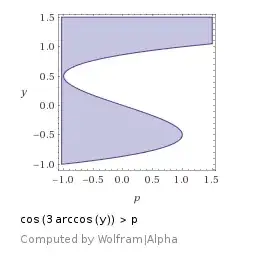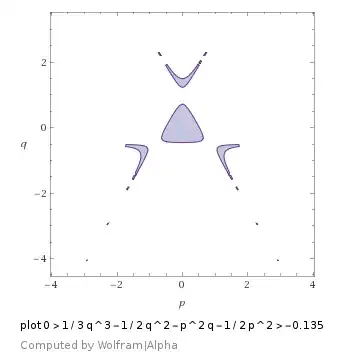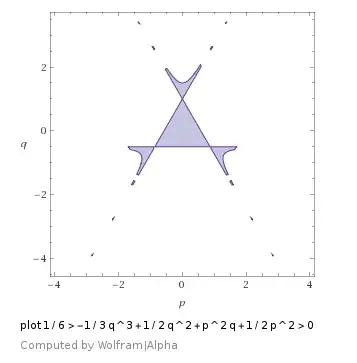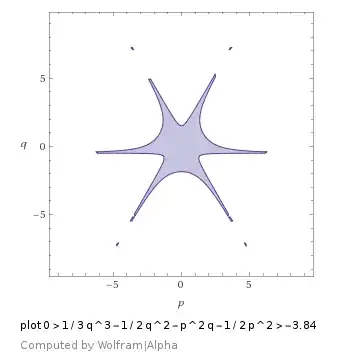$$\int_{0}^{c} dy \sqrt{\frac{c-1/2y^2+1/3y^3}{1+2y}}$$ where c is a constant. This is coming from trying to find the area $$\int_{U \le c} dq_1dq_2$$ where $$U=\frac{1}{2}(q_1^2+q_2^2)-\frac{1}{3}q_2^3+q_1^2q_2$$ bounded by energy $c=U(q_1,q_2)$.
-
What have you done to try and solve it? – Santana Afton Nov 23 '18 at 23:43
-
Tried to solve for the cubic term and then realized I didn’t want to deal with all the solutions, so solve for the quadratic $q_1$ And that leads me directly to this integral that I don’t know how to solve – Некто Nov 23 '18 at 23:58
-
I bet that you would face very nasty elliptic integrals. – Claude Leibovici Nov 24 '18 at 06:04
-
Are you sure the region of the plane described by $U\le e$ is even finite? – David H Nov 24 '18 at 20:05
-
Yes the phase space volume $\Omega(E)$ is bounded by the energy surface $H(p_1, p_2, q_1, q_2)=E$. I'm expressing this volume in terms of the area in the region $(q_1,q_2)$ which is bounded by $U(q_1,q_2)=e$ – Некто Nov 24 '18 at 21:44
-
What is the range of $y$? Maybe some approximation is possible? Otherwise, it may be better to set up an ODE and solve it numerically – Yuriy S Nov 24 '18 at 23:10
-
@Некто Unless I've made a mistake, the region you describe includes all $(q_1,q_2)$ such that $|q_1|\le1$ and $0\le q_2$ as a subset, and the area of this subset is of course infinite. So we have a problem... – David H Nov 24 '18 at 23:49
-
I’m fairly sure that the bounds for $q_2$ should be 0 to e – Некто Nov 25 '18 at 03:15
-
1@Некто That helps a lot. Also, to reiterate Yuri's question, are you using $e$ to denote the base of the natural logarithm, or are you using to denote an arbitrary constant? If it's the latter, WHYYYYY would you ever do such a thing? – David H Nov 25 '18 at 06:56
-
That's correct, I've changed it to c – Некто Nov 25 '18 at 18:16
-
Mathematica finds a complex solution of the integral in the form of a sum of elliptic integrals of the first and second kind. – stocha Nov 28 '18 at 08:32
-
1The domain of integration in the original problem is not convex and is not compact. So there are doubts that the proposed integral solves the problem of finding the area. Therefore, it makes sense to analyse cubic equation in the polar coordinates. This approach is detalized in my answer. – Yuri Negometyanov Dec 02 '18 at 15:02
-
1BTW, the proposed integral does not converge – Yuri Negometyanov Dec 03 '18 at 09:19
3 Answers
(Not an answer, just a comment that was too long).
You can prove that the value of the integral is $\frac{c^2}{2\sqrt{6}} + O(c)$ with the following algebraic simplifications. First note that the integral can be written as $$ I = \frac{1}{\sqrt{6}}\int_0^c \sqrt{ (y-1)^2 + \frac{6c-1}{2y+1}} \ dy. $$ It follows that $$I > \frac{1}{\sqrt{6}} \int_0^c (y-1) \ dy = \frac{c(c-2)}{2\sqrt{6}}.$$ Similarly, using the fact that $\sqrt{a+b} < \sqrt{a} + \sqrt{b}$ (which does not quite hold in some regions of the domain but seems to be insignificant for large $c$), we have $$ I < \frac{1}{\sqrt{6}} \int_0^c (y-1) \ dy + \frac{1}{\sqrt{6}}\int_0^c \sqrt{\frac{6c-1}{2y+1}} \ dy = \frac{c^2}{2\sqrt{6}} + O(c).$$ Thus we can conclude that $I = \frac{c^2}{2\sqrt{6}} + O(c).$ I think what could possibly help you is the following:
- If you want just a numerical answer, the function you are integrating is very smooth and convex so getting high precision values is doable.
- If you want a more accurate answer, you need to specify what regions of $c$ you are interested in. My answer holds for $c \rightarrow \infty$ but there are certainly more accurate answers for other cases such as $c << 1$.
- 8,135
$$\color{brown}{\textbf{Edition of 02.12.2018}}$$
HINT
The issue task is the task about the area under not convex figure.
In particular, for $C=0.135$ the graph is
for $C=\frac16$ the graph is
and for $C=3.84$ the graph is
These figures show, that the proposed integral can't calculate the area correctly, and it can be suitable to calculate the area in polar coordinates.
Let $$q_1=r\cos \varphi, \quad q_2=r \sin\varphi,$$ then $$U(r,\varphi) = \dfrac13r^3\sin 3\varphi+\dfrac12r^2.\tag1$$ Taking in account the properties of the sine function, it is sufficiently to consider $U(r,\varphi)$ at the interval $$\varphi\in\left(\frac\pi6,\frac\pi2\right).$$ The bounds determines by the system of inequalities \begin{cases} \dfrac13r^3\sin 3\varphi+\dfrac12r^2 > 0\\ \dfrac13r^3\sin 3\varphi+\dfrac12r^2 < C.\tag2 \end{cases} The first inequality has the solution $$\begin{cases} r\in(0,\infty),\quad \text{if}\quad \varphi\in\left(\dfrac\pi6,\dfrac\pi3\right)\\ r\in\left(0,-\dfrac3{2\sin3\varphi}\right),\quad \text{if}\quad \varphi\in\left(\dfrac\pi3,\dfrac\pi2\right) \end{cases}\tag3$$ Factor $\dfrac4{Cr^3}$ allows to present the second inequality in the form of $$\dfrac{4}{r^3} - \dfrac2{Cr} > \dfrac{4\sin3\varphi}{3C},$$ or $$4\left(\dfrac ar\right)^3-3\dfrac{a}r > p,\tag4$$ where $$a=\sqrt{\dfrac{3C}2},\quad p=2a\sin3\varphi.\tag5$$ $\textbf{If p < 1,}$ then can be used representation $$\cos\left(3\arccos\left(\dfrac ar\right)\right) > p.$$ Then $$\dfrac ar\in \begin{cases} [0,1],\quad\text{if}\quad p\in[-\infty,-1)\\ \left[\cos\left(\dfrac13\arccos p\right),\infty \right]\bigcup\left[0,\cos\left(\dfrac{2\pi}3-\dfrac13\arccos p\right)\right],\quad\text{if}\quad p\in[-1,1] \end{cases} $$ (see also Wolfram Alpha)
 $$r\in
\begin{cases}
[a,\infty],\text{ if }p\in[-\infty,-1)\\
\left[0,\dfrac a{\cos\left(\dfrac13\arccos p\right)}\right] \bigcup\left[\dfrac a{\cos\left(\dfrac{2\pi}3-\dfrac13\arccos p\right)},\infty\right],\text{ if } p\in[-1,1],
\end{cases}\tag6
$$
$\textbf{If p > 1,}$ then can be used representation
$$\cosh\left(3\cosh^{-1}\left(\dfrac ar\right)\right) > p,$$
$$ r < \dfrac a{\cosh\left(\dfrac13\cosh^{-1}p\right)},$$
wherein
$$\cosh^{-1}x = \log(x+\sqrt{x^2-1}),$$
$$\cosh\left(\dfrac13\cosh^{-1}x\right)=\dfrac12\left(\sqrt[3]{x+\sqrt{x^2-1}}+\dfrac1{\sqrt[3]{x+\sqrt{x^2-1}}}\right).$$
So
$$r < \dfrac {2a}{\sqrt[3]{p+\sqrt{p^2-1}}+\sqrt[3]{p-\sqrt{p^2-1}}}.\tag7$$
Besides, $r\ge0.$
Let us consider two examples.
$$r\in
\begin{cases}
[a,\infty],\text{ if }p\in[-\infty,-1)\\
\left[0,\dfrac a{\cos\left(\dfrac13\arccos p\right)}\right] \bigcup\left[\dfrac a{\cos\left(\dfrac{2\pi}3-\dfrac13\arccos p\right)},\infty\right],\text{ if } p\in[-1,1],
\end{cases}\tag6
$$
$\textbf{If p > 1,}$ then can be used representation
$$\cosh\left(3\cosh^{-1}\left(\dfrac ar\right)\right) > p,$$
$$ r < \dfrac a{\cosh\left(\dfrac13\cosh^{-1}p\right)},$$
wherein
$$\cosh^{-1}x = \log(x+\sqrt{x^2-1}),$$
$$\cosh\left(\dfrac13\cosh^{-1}x\right)=\dfrac12\left(\sqrt[3]{x+\sqrt{x^2-1}}+\dfrac1{\sqrt[3]{x+\sqrt{x^2-1}}}\right).$$
So
$$r < \dfrac {2a}{\sqrt[3]{p+\sqrt{p^2-1}}+\sqrt[3]{p-\sqrt{p^2-1}}}.\tag7$$
Besides, $r\ge0.$
Let us consider two examples.
$$\textbf{Example C=0.135, a=0.45}$$ The control points are $$p\left(\dfrac\pi6\right)=0.9,\quad p\left(\dfrac\pi3\right)=0,\quad p\left(\dfrac{2\pi}5\right)=-0.593083,\quad p\left(\dfrac\pi2\right)=-0.9,$$ $$r\left(\dfrac\pi6\right)\in(0,0.455304),\quad r\left(\dfrac\pi3\right)\in(0,0.519615),\quad r\left(\dfrac{2\pi}5\right)\in(0,0.519615)\cup(2.43582,2.55195),\quad r\left(\dfrac\pi2\right)\in((0,0.721023)\cup(1.23406,1.5)).$$
System $(2)$ has solutions $$\left[\begin{align} r\in\left(0,\dfrac {0.45}{\cos\left(\dfrac13\arccos (0.9\sin3\varphi)\right)}\right),\quad \text{if}\quad \varphi\in\left(\dfrac\pi6,\dfrac\pi2\right)\\ r\in\left(\dfrac {0.45}{\cos\left(\dfrac{2\pi}3-\dfrac13\arccos(0.9\sin3\varphi) \right)},-\dfrac3{2\sin3\varphi}\right),\quad \text{if}\quad \varphi\in\left(\dfrac\pi3,\dfrac\pi2\right) \end{align}\right.\tag8$$ The obtained results correspond with the first graph.
$$\textbf{Example C=3.84, a=2.4}$$ The control points are $$p\left(\dfrac\pi6\right)=4.8,\quad p\left(\dfrac\pi3-\dfrac13\arcsin\dfrac5{24}\right)=1,\quad p\left(\dfrac\pi3-\dfrac13\arcsin 0.2\right)=0.96,\quad p\left(\dfrac\pi3\right)=0,\quad p\left(\dfrac\pi3+\dfrac13\arcsin 0.2\right)=-0.96,\quad p\left(\dfrac\pi3+\dfrac13\arcsin\dfrac5{24}\right)=-1,\quad p\left(\dfrac{2\pi}5\right)=-2.82137, \quad p\left(\dfrac\pi2\right)=-4.8,$$ $$r\left(\dfrac\pi6\right)\in(0,1.85345),\quad r\left(\dfrac\pi3-\dfrac13\arcsin\dfrac5{24}\right)=(0,2.4),\quad r\left(\dfrac\pi3-\dfrac13\arcsin0.2\right)=(0,2.41078),\quad r\left(\dfrac\pi3\right)\in(0,2.77128),\quad r\left(\dfrac\pi3+\dfrac13\arcsin0.2\right)=(0,4.14103)\cup(5.76975,7.5),\quad r\left(\dfrac\pi3+\dfrac13\arcsin\dfrac5{24}\right)=(0,7.2),\quad r\left(\dfrac{2\pi}5\right)\in(0,2.55195),\quad r\left(\dfrac\pi2\right)\in(0,1.5).$$
System $(2)$ has solutions $$\begin{cases} r\in\left(0,\dfrac {4.8}{\sqrt[3]{4.8\sin3\varphi+\sqrt{(4.8\sin3\varphi)^2-1}}+\sqrt[3]{4.8\sin3\varphi-\sqrt{(4.8\sin3\varphi)^2-1}}}\right),\quad \text{if}\quad \varphi\in\left(\dfrac\pi6,\dfrac\pi3-\dfrac13\arcsin\dfrac5{24}\right)\\ r\in\left(0,\dfrac {2.4}{\cos\left(\dfrac13\arccos (4.8\sin3\varphi)\right)}\right),\quad \text{if}\quad \varphi\in\left(\dfrac\pi3-\dfrac13\arcsin\dfrac5{24},\dfrac\pi3\right)\\ r\in\left(0,\dfrac {2.4}{\cos\left(\dfrac13\arccos (4.8\sin3\varphi)\right)}\right)\bigcup\left(\dfrac {2.4}{\cos\left(\dfrac{2\pi}3-\dfrac13\arccos(4.8\sin3\varphi) \right)},-\dfrac3{2\sin3\varphi}\right),\quad \text{if}\quad \varphi\in\left(\dfrac\pi3,\dfrac\pi3+\dfrac13\arcsin\dfrac5{24}\right)\\ r\in\left(0,-\dfrac3{2\sin3\varphi}\right),\quad \text{if}\quad \varphi\in\left(\dfrac\pi3+\dfrac13\arcsin\dfrac5{24},\dfrac\pi2\right) \end{cases}\tag9$$ The obtained results correspond with the third graph.
$\textbf{Finding the area}$
The area of figure in the polar coordinates equals to
$$S=6\cdot\dfrac12\int\limits_{\pi/6}^{\pi/2}r^2(\varphi)\,\mathrm d\varphi.$$
In particular, for $C=0.135$
$$S=6\cdot\dfrac12\int\limits_{\pi/6}^{\pi/2}\dfrac {0.45^2}{\cos^2\left(\dfrac13\arccos (0.9\sin3\varphi)\right)}\,\mathrm d\varphi +6\cdot\dfrac12\int\limits_{\pi/3}^{\pi/2}\left(\dfrac{9}{4\sin^2(3\varphi)} - \dfrac {0.45^2}{\cos^2\left(\dfrac{2\pi}3-\dfrac13\arccos (0.9\sin3\varphi)\right)}\right)\,\mathrm d\varphi \approx 0.968088 + 0.968088 = \mathbf{1.937376}$$ (see also Wolfram Alpha for the first integral and for the second one)
- 28,026
-
-
@Diger In $(8)$ the bracket is square. I.e. the first solution exists everywhere. – Yuri Negometyanov Dec 02 '18 at 16:32
-
Yes, but you write $\varphi \in (\pi/6,\pi/2)$, but isn't this the part where you should separate between $(\pi/6,\pi/3)$ and $(\pi/3,\pi/2)$ as in (3). And what special is the point $2\pi/5$ ? – Diger Dec 02 '18 at 16:40
-
@Diger 1. This is another form of presentation. 2. the point $\dfrac{2\pi}5$ is one of the intermediate points, where the formulas and the figures were compared. – Yuri Negometyanov Dec 02 '18 at 16:56
The Appell-Lauricella function is defined by the series $$ F[\{a,c\};\{b_1,b_2,\dots,b_n\};\{x_1,x_2,\ldots,x_n\}]:= $$ $$ =\sum_{i_1,i_2,\ldots,i_n\geq 0}\frac{(a)_{i_1+i_2+\ldots+i_n}(b_1)_{i_1}(b_2)_{i_2}\ldots(b_n)_{i_n}}{(c)_{i_1+i_2+\ldots+i_n}i_1!i_2!\ldots i_n!}x_1^{i_1}x_2^{i_2}\ldots x_n^{i_n}, $$ where $n\geq2$, $a,c,b_1,b_2,\ldots,b_n\in\textbf{C}$ and $|x_1|<1,|x_2|<1,\ldots,|x_n|<1$.
Then holds the following
THEOREM. For $Re(c)>Re(a)>0$ and $|x_1|<1,|x_2|<1,\ldots,|x_n|<1$, we have $$ F[\{a,c\};\{b_1,b_2,\dots,b_n\};\{x_1,x_2,\ldots,x_n\}]= $$ $$ =\frac{\Gamma(c)}{\Gamma(a)\Gamma(c-a)}\int^{1}_{0}t^{a-1}(1-t)^{c-a-1}(1-x_1t)^{-b_1}(1-x_2t)^{-b_2}\ldots (1-x_nt)^{-b_n}dt. $$
Using the above theorem I will prove that
$$ \int^{c}_{0}\sqrt{\frac{c-y^2/2+y^3/3}{1+2y}}dy= \frac{c\sqrt{4-l}}{2\sqrt{6}}|l-1|\times $$ $$ \times F\left[\{1,2\};\{\frac{1}{2},-\frac{1}{2},-\frac{1}{2},-\frac{1}{2}\};\{-2c,\frac{2c}{l-1},\frac{4c}{4-l-\sqrt{3}\sqrt{(4-l)l}},\frac{4c}{4-l+\sqrt{3}\sqrt{(4-l)l}}\}\right], $$ where $c=\frac{1}{24}(4-9l+6l^2-l^3)$.
For to prove the above evaluation make the change of variable $y\rightarrow -y$ to get $$ \int^{c}_{0}\sqrt{\frac{c-y^2/2+y^3/3}{2y+1}}dy=i\int^{-c}_{0}\sqrt{\frac{y^2/2+y^3/3-c}{-2y+1}}dy, $$ then $y\rightarrow \frac{1-w}{2}$ to get $$ i\int^{-c}_{0}\sqrt{\frac{y^2/2+y^3/3-c}{-2y+1}}dy=\frac{\sqrt{c}}{4\sqrt{6}}\int^{2c+1}_{1}\sqrt{\frac{24+1/c(w-4)(w-1)^2}{w}}dw. $$ Now if $c=\frac{1}{24}(4-9l+6l^2-l^3)$ we can write $$ 24+(-4+w)(-1+w)^2/c=\frac{24(l-w)(9-6l+l^2-6w+lw+w^2)}{(l-4)(l-1)^2}. $$ Hence we can write the last integral in the form of theorem and use it to get the result, which is the Appell-Lauricella function.
- 7,248


